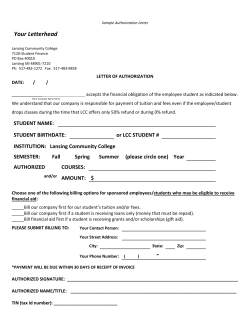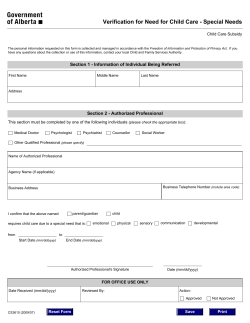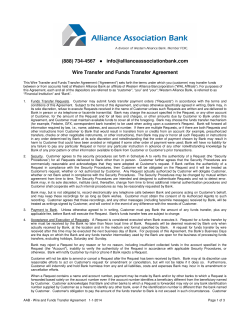
3 Perceiving Ourselves and Others in Organizations
3 Perceiving Ourselves and Others in Organizations © 2015 by McGraw-Hill Education. This is proprietary material solely for authorized instructor use. Not authorized for sale or distribution in any manner. This document may not be copied, scanned, duplicated, forwarded, distributed, or posted on a website, in whole or part. 1 McShane/Von Glinow OB 7e Changing Self and Other Perceptions of Female Firefighters Emily MacDonald (shown) attended Camp FFit in Ottawa, Canada, a program that helps teenage girls develop a selfconcept as firefighters, develop their self-esteem, and dispel the occupation’s macho stereotype. © 2015 by McGraw-Hill Education. This is proprietary material solely for authorized instructor use. Not authorized for sale or distribution in any manner. This document may not be copied, scanned, duplicated, forwarded, distributed, or posted on a website, in whole or part. 2 McShane/Von Glinow OB 7e Self-Concept Defined An individual’s self-beliefs and selfevaluations “Who am I?” and “How do I feel about myself?” Compare perceived job with our perceived and ideal selves. Includes three self-concept characteristics and four “selves” processes © 2015 by McGraw-Hill Education. This is proprietary material solely for authorized instructor use. Not authorized for sale or distribution in any manner. This document may not be copied, scanned, duplicated, forwarded, distributed, or posted on a website, in whole or part. 3 McShane/Von Glinow OB 7e Self-Concept Model: Three C’s and Four Selves Self-Concept •complexity •consistency •clarity © 2015 by McGraw-Hill Education. This is proprietary material solely for authorized instructor use. Not authorized for sale or distribution in any manner. This document may not be copied, scanned, duplicated, forwarded, distributed, or posted on a website, in whole or part. 4 McShane/Von Glinow OB 7e Self-Concept Characteristics (3 C’s) Complexity We perceive multiple self-views High complexity: several identities with little overlap Consistency Multiple selves require compatible personality, values Clarity Self-concept is clear, confidently described, internally consistent, and stable across time. People have better well-being with: multiple selves (complexity) well established selves (clarity) selves are similar and compatible with traits (consistency) © 2015 by McGraw-Hill Education. This is proprietary material solely for authorized instructor use. Not authorized for sale or distribution in any manner. This document may not be copied, scanned, duplicated, forwarded, distributed, or posted on a website, in whole or part. 5 McShane/Von Glinow OB 7e Four “Selves” of Self-Concept Self-enhancement Promoting and protecting our positive self-view Self-verification Affirming and maintaining our existing self-concept Self-evaluation Evaluating ourselves through self-esteem, selfefficacy, and locus of control Social self Defining ourselves by our group membership © 2015 by McGraw-Hill Education. This is proprietary material solely for authorized instructor use. Not authorized for sale or distribution in any manner. This document may not be copied, scanned, duplicated, forwarded, distributed, or posted on a website, in whole or part. 6 McShane/Von Glinow OB 7e Self-Concept: Self-Enhancement Drive to promote/protect a positive self-view competent, attractive, lucky, ethical, valued Self-enhancement outcomes: better personal adjustment and mental/physical health Higher “can-do” attitude Inflates perceived personal causation and chances of success © 2015 by McGraw-Hill Education. This is proprietary material solely for authorized instructor use. Not authorized for sale or distribution in any manner. This document may not be copied, scanned, duplicated, forwarded, distributed, or posted on a website, in whole or part. 7 McShane/Von Glinow OB 7e Self-Concept: Self-Verification Motivation to verify/maintain our self-concept Stabilizes our self-concept Prefer feedback consistent with self-concept Self-verification outcomes: More likely to remember information consistent with our self-concept Less likely to accept feedback that differs from our selfconcept Motivated to be with those who affirm/reflect our selfconcept © 2015 by McGraw-Hill Education. This is proprietary material solely for authorized instructor use. Not authorized for sale or distribution in any manner. This document may not be copied, scanned, duplicated, forwarded, distributed, or posted on a website, in whole or part. 8 McShane/Von Glinow OB 7e Self-Concept: Self-Evaluation Self-esteem High self-esteem: less influenced by others, more persistent, more logical thinking Self-efficacy Belief that we can successfully perform a task Perceived support from MARS model elements General self-efficacy – “can-do” belief across situations Locus of control General belief about personal control over life events Higher self-evaluation with internal locus of control © 2015 by McGraw-Hill Education. This is proprietary material solely for authorized instructor use. Not authorized for sale or distribution in any manner. This document may not be copied, scanned, duplicated, forwarded, distributed, or posted on a website, in whole or part. 9 McShane/Von Glinow OB 7e Self-Concept: Social Self • Social identity -- defining ourselves in terms of groups to which we belong or have an emotional attachment • Groups selected when easily identified, your membership is the exception, the group has high status Contrasting Groups Social Identity Edward Jones Employee American Resident/Citizen An individual’s social identity Indiana U. Graduate © 2015 by McGraw-Hill Education. This is proprietary material solely for authorized instructor use. Not authorized for sale or distribution in any manner. This document may not be copied, scanned, duplicated, forwarded, distributed, or posted on a website, in whole or part. 10 Employees at other firms People living in other countries Graduates of other schools McShane/Von Glinow OB 7e Perception Defined The process of receiving information about and making sense of the world around us Determining which information gets noticed Determining how to categorize this information Determining how to interpret information within our existing knowledge © 2015 by McGraw-Hill Education. This is proprietary material solely for authorized instructor use. Not authorized for sale or distribution in any manner. This document may not be copied, scanned, duplicated, forwarded, distributed, or posted on a website, in whole or part. 11 McShane/Von Glinow OB 7e Selective Attention Selecting vs ignoring sensory information Affected by features of person/object – size, motion Affected by the perceiver’s characteristics – assumptions, expectations, needs Emotional markers are assigned to selected information Confirmation bias Screening out information contrary to our beliefs/values © 2015 by McGraw-Hill Education. This is proprietary material solely for authorized instructor use. Not authorized for sale or distribution in any manner. This document may not be copied, scanned, duplicated, forwarded, distributed, or posted on a website, in whole or part. 12 McShane/Von Glinow OB 7e Perceptual Organization/Interpretation Categorical thinking Mostly nonconscious process of organizing people/things (perceptual grouping) Perceptual grouping principles Similarity or proximity Closure -- filling in missing pieces Perceiving trends Interpreting incoming information Emotional markers automatically evaluate information © 2015 by McGraw-Hill Education. This is proprietary material solely for authorized instructor use. Not authorized for sale or distribution in any manner. This document may not be copied, scanned, duplicated, forwarded, distributed, or posted on a website, in whole or part. 13 McShane/Von Glinow OB 7e Mental Models in Perceptions Internal representations of the external world Help make sense of situations Fill in missing pieces Help to predict events Problem with mental models: May block recognition of new opportunities/perspectives © 2015 by McGraw-Hill Education. This is proprietary material solely for authorized instructor use. Not authorized for sale or distribution in any manner. This document may not be copied, scanned, duplicated, forwarded, distributed, or posted on a website, in whole or part. 14 McShane/Von Glinow OB 7e Stereotyping Assigning traits to people based on social category membership Why people stereotype: Categorical thinking Innate drive to comprehend and predict others’ behavior Supports self-enhancement and social identity © 2015 by McGraw-Hill Education. This is proprietary material solely for authorized instructor use. Not authorized for sale or distribution in any manner. This document may not be copied, scanned, duplicated, forwarded, distributed, or posted on a website, in whole or part. 15 McShane/Von Glinow OB 7e Stereotyping Through Categorization, Homogenization, Differentiation Social identity and self-enhancement reinforce stereotyping through: Categorization process -- Categorize people into groups Homogenization process -- Assign similar traits within a group; different traits to other groups Differentiation process -- Assign less favorable attributes to other groups © 2015 by McGraw-Hill Education. This is proprietary material solely for authorized instructor use. Not authorized for sale or distribution in any manner. This document may not be copied, scanned, duplicated, forwarded, distributed, or posted on a website, in whole or part. 16 McShane/Von Glinow OB 7e Problems with Stereotyping Problems with stereotyping Overgeneralizes – doesn’t represent everyone in the category Basis of systemic and intentional discrimination Overcoming stereotype biases Difficult to prevent stereotype activation Possible to minimize stereotype application © 2015 by McGraw-Hill Education. This is proprietary material solely for authorized instructor use. Not authorized for sale or distribution in any manner. This document may not be copied, scanned, duplicated, forwarded, distributed, or posted on a website, in whole or part. 17 McShane/Von Glinow OB 7e Attribution Process Internal Attribution External Attribution Perception that behavior is caused by factors beyond person’s control (situation, fate, etc.) Perception that behavior is caused by person’s own motivation or ability © 2015 by McGraw-Hill Education. This is proprietary material solely for authorized instructor use. Not authorized for sale or distribution in any manner. This document may not be copied, scanned, duplicated, forwarded, distributed, or posted on a website, in whole or part. 18 McShane/Von Glinow OB 7e Attribution Rules Internal Attribution High consistency Low distinctiveness Low consensus Consistency Distinctiveness Consensus High consistency High distinctiveness High consensus External Attribution © 2015 by McGraw-Hill Education. This is proprietary material solely for authorized instructor use. Not authorized for sale or distribution in any manner. This document may not be copied, scanned, duplicated, forwarded, distributed, or posted on a website, in whole or part. 19 McShane/Von Glinow OB 7e Attribution Errors Self-Serving Bias Tendency to attribute our successes to internal factors and our failures to external factors Fundamental Attribution Error Tendency to overemphasize internal causes of another person’s behavior, whereas we recognize external influences on our own behavior This error is less common that previously thought © 2015 by McGraw-Hill Education. This is proprietary material solely for authorized instructor use. Not authorized for sale or distribution in any manner. This document may not be copied, scanned, duplicated, forwarded, distributed, or posted on a website, in whole or part. 20 McShane/Von Glinow OB 7e Self-Fulfilling Prophecy Cycle Supervisor forms expectations Employee’s behavior matches expectations Expectations affect supervisor’s behavior Supervisor’s behavior affects employee © 2015 by McGraw-Hill Education. This is proprietary material solely for authorized instructor use. Not authorized for sale or distribution in any manner. This document may not be copied, scanned, duplicated, forwarded, distributed, or posted on a website, in whole or part. 21 McShane/Von Glinow OB 7e Self-Fulfilling Prophecy Effect is Strongest... ...at the beginning of the relationship (e.g. employee joins the team) ...when several people have similar expectations about the person ...when the employee has low rather than high past achievement © 2015 by McGraw-Hill Education. This is proprietary material solely for authorized instructor use. Not authorized for sale or distribution in any manner. This document may not be copied, scanned, duplicated, forwarded, distributed, or posted on a website, in whole or part. 22 McShane/Von Glinow OB 7e Other Perceptual Effects Halo effect One trait affects perception of person’s other traits False-consensus effect Overestimate how many others have similar beliefs or traits like ours Three causes Primacy effect First impressions are difficult to change Recency effect Most recent information dominates perceptions © 2015 by McGraw-Hill Education. This is proprietary material solely for authorized instructor use. Not authorized for sale or distribution in any manner. This document may not be copied, scanned, duplicated, forwarded, distributed, or posted on a website, in whole or part. 23 McShane/Von Glinow OB 7e Improving Perceptions 1. Awareness of perceptual biases 2. Improving self-awareness Applying Johari Window 3. Meaningful interaction Based on contact hypothesis Close, frequent interaction toward a shared goal Engaged in a meaningful task Equal status © 2015 by McGraw-Hill Education. This is proprietary material solely for authorized instructor use. Not authorized for sale or distribution in any manner. This document may not be copied, scanned, duplicated, forwarded, distributed, or posted on a website, in whole or part. 24 McShane/Von Glinow OB 7e Know Yourself (Johari Window) Feedback Known to Self Known to Others Disclosure Open Area Open Area Hidden Area Hidden Unknown to Others Blind Area Blind Area Unknown Unknown Area Area Area © 2015 by McGraw-Hill Education. This is proprietary material solely for authorized instructor use. Not authorized for sale or distribution in any manner. This document may not be copied, scanned, duplicated, forwarded, distributed, or posted on a website, in whole or part. Unknown to Self 25 McShane/Von Glinow OB 7e Global Mindset at Keppel O&M Global mindset is one of the core values at Keppel Offshore & Marine. The Singapore- based offshore rig designer and builder encourages staff to visit the company’s operations in other countries, attend debriefing sessions from those visits, and accept longer-term overseas assignments. © 2015 by McGraw-Hill Education. This is proprietary material solely for authorized instructor use. Not authorized for sale or distribution in any manner. This document may not be copied, scanned, duplicated, forwarded, distributed, or posted on a website, in whole or part. 26 McShane/Von Glinow OB 7e Global Mindset Abilities Ability to understand and respect other views/practices around the world Ability to empathize and act effectively across cultures Ability to process complex information about novel environments Ability to comprehend and reconcile intercultural matters with multiple levels of thinking © 2015 by McGraw-Hill Education. This is proprietary material solely for authorized instructor use. Not authorized for sale or distribution in any manner. This document may not be copied, scanned, duplicated, forwarded, distributed, or posted on a website, in whole or part. 27 McShane/Von Glinow OB 7e Developing a Global Mindset 1. Improve self-awareness 2. Compare mental models with people from other cultures 3. Develop better knowledge of people and cultures – especially through immersion © 2015 by McGraw-Hill Education. This is proprietary material solely for authorized instructor use. Not authorized for sale or distribution in any manner. This document may not be copied, scanned, duplicated, forwarded, distributed, or posted on a website, in whole or part. 28 McShane/Von Glinow OB 7e 3 Perceiving Ourselves and Others in Organizations © 2015 by McGraw-Hill Education. This is proprietary material solely for authorized instructor use. Not authorized for sale or distribution in any manner. This document may not be copied, scanned, duplicated, forwarded, distributed, or posted on a website, in whole or part. 29 McShane/Von Glinow OB 7e
© Copyright 2025












